értekezés - Budapesti Corvinus Egyetem
értekezés - Budapesti Corvinus Egyetem
értekezés - Budapesti Corvinus Egyetem
Create successful ePaper yourself
Turn your PDF publications into a flip-book with our unique Google optimized e-Paper software.
2. függelék - Likviditáskockázat és a Korn [2003] modell<br />
The studies by Zhou [1998], Mello and Parsons [2000], and Deep [2002] show that<br />
liquidity risk as a result of futures with continuous marking-to-market can severely<br />
influence optimal hedging strategies. In the context of a continuous-time equilibrium<br />
model of futures prices, Zhou [1998] – for example – investigates the hedging decisions of<br />
commodity producers who are faced with the constraint that their trading losses in the<br />
futures market cannot exceed a pre-specified level, and derives the producer’s optimal<br />
dynamic hedging strategy under the assumption of a logarithmic utility function. Mello and<br />
Parsons [2000] develop a model of a firm with limited borrowing capacity. They analyze<br />
how different hedging strategies with different expected liquidity needs affect firm values.<br />
Korn [2003], on the other hand, focuses on the liquidity needs resulting from the<br />
revaluation of forward contracts prior to maturity and the collateral calls in case of losses.<br />
Forwards differ substantially from futures with respect to liquidity consequences. Forwards<br />
are valued less frequently than futures over the maturity period. 162 Moreover, forwards<br />
cause cash outflows in the case of losses due to the financing of collateral purchases, but<br />
they do not cause cash inflows in the case of gains. Thus, in contrast to futures, forwards<br />
can be asymmetric with respect to liquidity consequences prior to maturity. 163 Since<br />
empirical evidence confirms that forward contracts are the predominant hedging<br />
instruments for many non-financial firms 164 , I give a synopsis on the findings of Korn<br />
[2003] with regards to the costs of liquidity risk below.<br />
The crucial feature of Korn’s [2003] model is that the firm must cover accumulated losses<br />
on its forward position with collateral. If the firm faces a positive credit spread on its<br />
funding, but receives only the risk free rate of return on its collateral, hedging has<br />
additional financing costs. Korn [2003] shows that firms with zero credit spreads choose to<br />
162 In practice, firms can choose whether they want to specify a margining clause in their OTC forward<br />
contracts that operates similarly to futures contracts with respect to marking-to-market, although with<br />
discrete ranges of mark-to-market settlements, or firms can ask for credit lines. In latter case, the resulting<br />
higher credit risk will be priced in the derivative, and there will be no cash call until the credit line is fully<br />
exploited.<br />
163 If gains have occurred on the forward position, the firm’s counterparty in the forward market might be<br />
obliged to provide collateral, however, our firm will not receive any cash inflows associated with the<br />
collateral.<br />
164 See, for example, Bodnar/Hayt/Marston [1998], or Bodnar/Gebhardt [1999].<br />
163
















